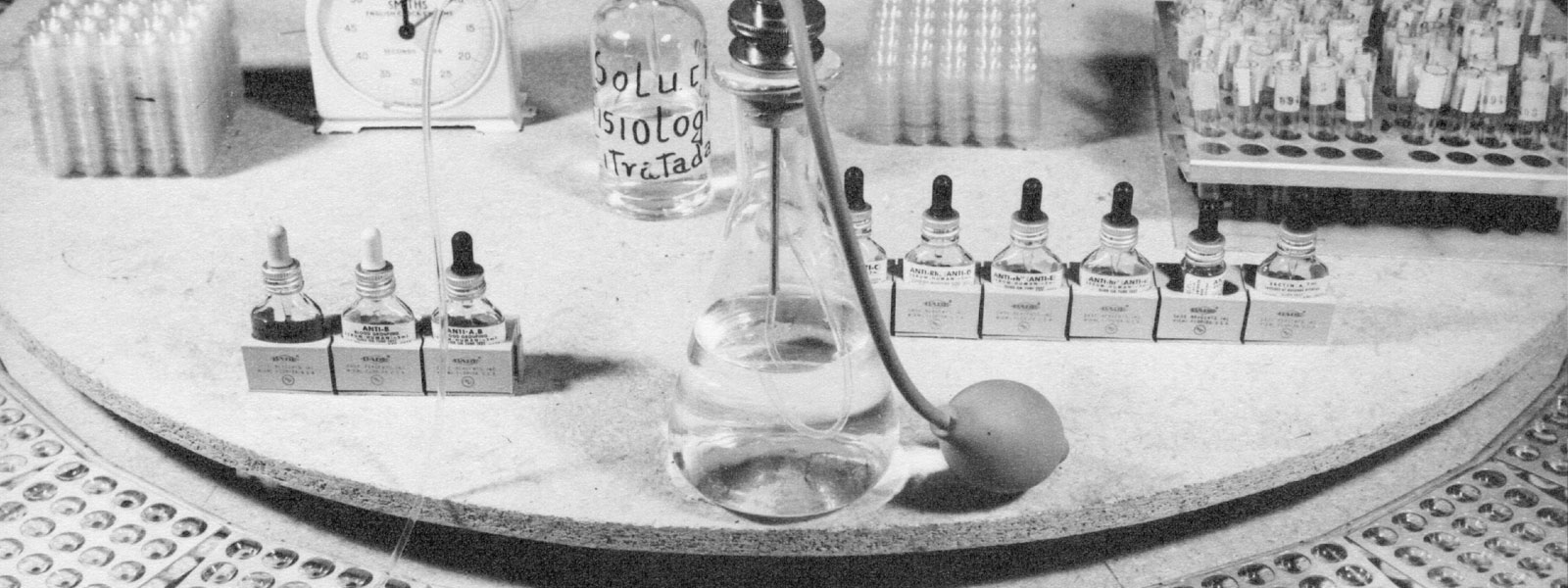Control sera and the ABO blood typing system
A breakthrough in transfusion safety
Technical file
Type of innovation: Reagent
Scope: Clinical Analysis; Hemotherapy
Innovation leader: Grifols i Roig, Josep Antoni; Grifols i Lucas, Víctor
Year: 1930
Period: 1909-1971
Geographical scope: Spain
Economic impact: Medium
Level of innovation: Disruptive
Patent: No
Interdisciplinary connections: -
At the beginning of the twentieth century, Karl Landsteiner observed that, when mixing the blood of two people, the red blood cells sometimes spontaneously clumped together to form lumps. Thankfully rare, this phenomenon was potentially highly dangerous and could even cause death after blood transfusions.
The ABO discovery
Puzzled, and determined to find answers, Landsteiner analyzed the blood of 22 people, including his own. He separated and washed the red blood cells from each sample and immersed them in a physiological saline solution to create control sera.
Mixing various blood samples with different sera caused three different types of agglutination reaction, which he named type A, B and O, respectively. The year was 1901, the place was Vienna, and the ABO blood typing system had just been born. Two years later, two of his pupils, Alfredo Castello and Adriano Sturli, discovered the fourth and last group, type AB.
Extending the role of sera
This was the dawn of hematology and hemotherapy, and at the time a young Josep Antoni Grifols i Roig was already working with sera with clumping properties. He was quick to realize the importance of the work of Landsteiner and his collaborators.
Grifols i Roig's own area of interest was the Wassermann reaction, which was used to detect syphilis. In around 1910 he completed his medical studies, proposing a new improved method to develop the sera used in the reaction. In the 1930s and 1940s he developed a deep and wide-ranging knowledge of sera reactions, which would evolve to become one of the pillars of the Grifols company.

“Grifols was a key part of the blood testing evolution, developing diagnostic cards that could be machine read and automatically analyzed.”
Further progress, including automation
Landsteiner made further progress with blood typing in 1940, this time in partnership with Alexander Salomon Wiener. Their joint discovery was the Rhesus (Rh) antigen. Combining Rh testing between donor and recipient with that of the ABO system created problems of incompatibility almost nil, and improved the safety and efficiency of all blood banks.
These days, automated blood typing systems have superseded the old manual techniques, but the basic science of sera remains intact. Grifols was a key part of this technological evolution, developing diagnostic cards that could be machine read and automatically analyzed.
Bibliography
Grifols-Roig, J.A. (1913). Contribución al perfeccionamiento del método y técnica de la Reacción de Wassermann (Doctoral thesis). Depositada en la Universidad de Barcelona.
Grifols-Roig, J.A. (1913). Valoració quantitativa de la reacció de Wassermann. Actes, ponència i comunicacions del Primer Congrés de Metges de Llengua Catalana, 535-545.
Moragas, R. (1913). La reacció aglutinant com a medi diagnòstic de les malalties infeccioses. Actes, ponència i comunicacions del Primer Congrés de Metges de Llengua Catalana, 331-379.
Grifols-Roig, J.A., & Hirsch, W. (1936). Sobre la desaparición de la zona negativa en las aglutinaciones del M. Melitensis, por medio de la inactivación del suero. Revista Médica de Barcelona, 149(25), 459-60.
Grifols-Roig, J.A. (1936). Una reacción de aglutinación del B. Eberth por la tripaflavina, según el Dr. W. Hirsch, en estrecha relación con el antígeno Vi. Medicina Latina, June-July, 287-294.
Laboratorios Grifols. (1944). Equipo para la determinación de los grupos sanguíneos. [Sales brochure]. Barcelona: Hemobanco de Sangre y Plasma de Laboratorios Grifols, S.A.
Grifols-Roig, J.A., et al. (1949). The Rh genotypes of 223 Spanish blood donors. Unpublished manuscript. London: Medical Research Council Blood Group, Lister Institute of London y Laboratorios Grifols, S.A.
Grifols-Lucas, J.A. (1953, June 10). Frecuencia de los grupos Kell y Duffy en la población española. Comunicación presentada en la Asociación de Hematología y Hemoterapia, Barcelona.
Grifols-Lucas, V. (1953, June 10). La dosis de antígeno en la titulación de los sueros anti-Rh. Paper presented at the Association of Hemathology and Hemotherapy, Barcelona.
Laboratorios Grifols. (1958). Todo buen analista sabe que: sus resultados son tan buenos como sus reactivos y tan seguros como sus controles. [Sales brochure]. Barcelona: Hemobanco de Sangre y Plasma de Laboratorios Grifols, S.A.
Grifols-Lucas, V. (2009). Amb un suro i un cordill. Vivències d'un empresari de postguerra. Barcelona: Grupo Grifols, S.A.
Avellà, R., & Miquel, B. (Eds.). (2015). Cuando un sueño se cumple. Crónica ilustrada de 75 años de Grifols. Barcelona: Grupo Grifols, S.A.
Rodríguez Sánchez, L. (2017). El laboratorio de inmunohematología. Revista Mexicana de Medicina Transfusional, 10(1), 5-13.
Mazana, J.S. (n.d.). Karl Landsteiner y los grupos sanguíneos. Cuba: Infomed, Centro Nacional de Información de Ciencias Médicas. Retrieved from http://www.sld.cu
Related innovations
SERVICE
Rhesus factor correspondence course
INSTRUMENT
Transfusion flebula
DEVICE
Microcentrifuge